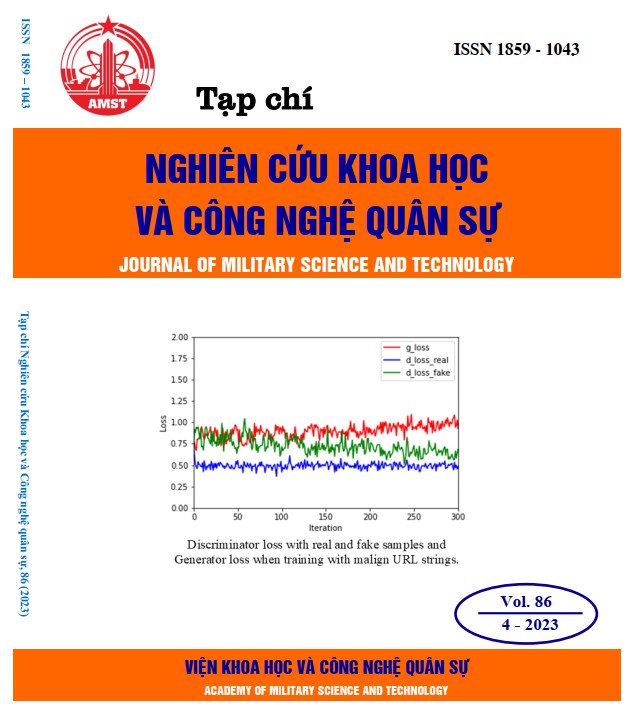Effects of the liner materials on penetration capability of explosively formed projectiles
432 viewsDOI:
https://doi.org/10.54939/1859-1043.j.mst.86.2023.144-150Keywords:
EFP; MCT-83; Material; Penetration of EFP.Abstract
Numerical simulations are carried out to study the effects of the liner material (Al, Cu, Mo, W, Ta) on the shape, mass, velocity, kinetic energy, length-to-diameter ratio, penetration depth and hole-diameter of MCT-83 mine (explosively formed projectile). The results of these parameters present the potential capability of each liner material used to fabricate explosively formed projectiles. Cu has get the maximum penetration depth value while Mo has the largest hole-diameter. The research results help to choose the material of liner suitable for each type of EFP warhead and for each different purposes.
References
[1]. Thông tin kỹ thuật quân sự nước ngoài, số 67, 07/1996, (in Vietnamese).
[2]. Đỗ Quốc Vì, Trần Đình Thành, “Nghiên cứu mô phỏng quá trình hình thành và va xuyên của mìn chống tăng MCT-83 theo nguyên lý nổ tạo hình bằng phần mềm ANSYS AUTODYN-2D”, Hội nghị các nhà nghiên cứu trẻ lần thứ XVI, Học viện KTQS, (2021) (in Vietnamese).
[3]. T. T. Dũng, “Nghiên cứu thiết kế, chế tạo mìn chống tăng đánh sườn MCT-83 định hướng theo kiểu mìn TM-83 của Liên Bang Nga”, đề tài Cấp Quốc gia, Viện Vũ khí/ TC CNQP, (2020) (in Vietnamese).
[4]. Под ред, Орленко Л. П, Физика взрыва ТOM.1, TOM.2 ФИЗМАТЛИТ, (2002).
[5]. Под ред, Орленко Л. П, Физика взрыва и удара ФИЗМАТЛИТ, (2006).
[6]. Ulrich Hornemann, “Explosively formed projectile warheads”, Miltech 04, p.36-40, (1987).
[7]. ANSYS release 17.2 Documentation, ANSYS Inc, (2017).
[8]. G. Hussain, A. Hameed, A. Q. Malik, K. Sanaullah, “Analytical performance study of explosively formed projectiles”, Journal of Applied Mechanics and Technical Physics, (2013). DOI: https://doi.org/10.1134/S0021894413010021
[9]. M. Katayama, Minamisuna, “Numerical and experimental study on the shaped charge for space debris assessment”, Acia Astronauuca Vol 48, (2001). DOI: https://doi.org/10.1016/S0094-5765(01)00073-X
[10]. Weimann K, “Performance of Ta, Cu and Fe EFPs Against Steel Targets”, 15th Int. Symp. On Ballistics, Vol 2, (1995).
[11]. Rondot Fb, “Performance of Ta EFP Simulants”, 17th Int. Symp. on Ballistics, Vol. 3, (1998).
[12]. Cardoso, D., Teixeira-Dias, F. “Modelling the formation of explosively formed projectiles (EFP)”. Int. J. Impact Eng, (2016). DOI: https://doi.org/10.1016/j.ijimpeng.2016.02.014
[13]. Liu, J. and et.al. “The influence of liner material on the dynamic response of the finite steel target subjected to high velocity impact by explosively formed projectile”. Int. J. Impact Eng, (2017). DOI: https://doi.org/10.1016/j.ijimpeng.2017.07.002
[14]. Wu, J. and et.al. “Experimental and numerical study on the flight and penetration properties of explosively-formed projectile”. Int. J. Impact Eng, (2007). DOI: https://doi.org/10.1016/j.ijimpeng.2006.06.007
[15]. Borkowski, J. and et.al. “Application of sintered liners for explosively formed projectile charges”. Int. J. Impact Eng, (2018). DOI: https://doi.org/10.1016/j.ijimpeng.2018.04.009
[16]. Pappu, S.; Murr, L.E. “Hydrocode and microstructural analysis of explosively formed penetrators”. J. Mater. Sci, (2002).







